The logic of consciousness. Part 2. Dendritic waves
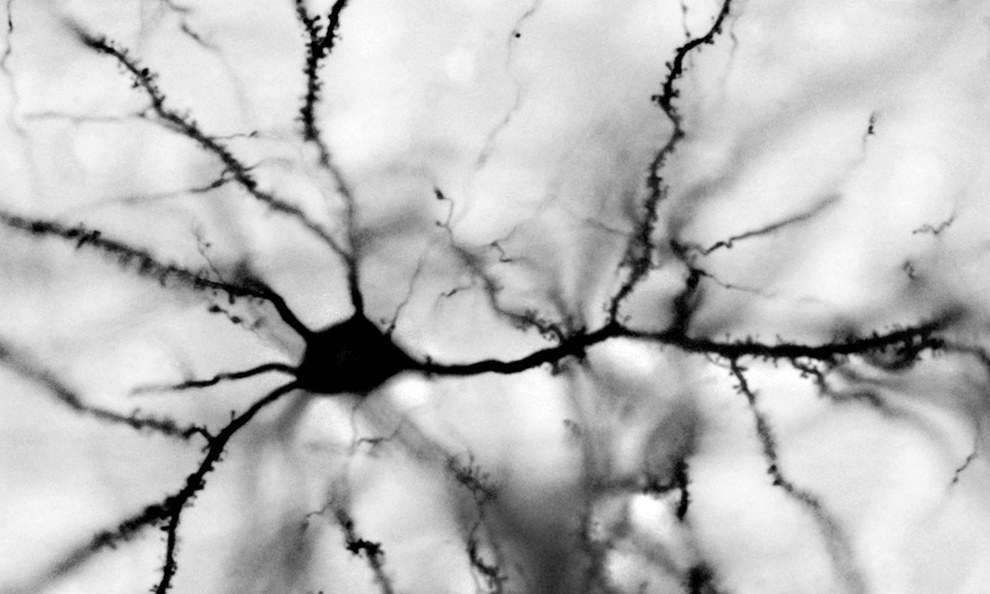 In the previous section, we showed that waves with a specific internal pattern can occur in a cellular automaton. Such waves can be triggered from anywhere in the cellular automaton and spread throughout the cell space of the automaton, transferring information. It is tempting to assume that the real brain can use similar principles. In order to understand the possibility of analogy, let's a little understand how the neurons of the real brain work.
In the previous section, we showed that waves with a specific internal pattern can occur in a cellular automaton. Such waves can be triggered from anywhere in the cellular automaton and spread throughout the cell space of the automaton, transferring information. It is tempting to assume that the real brain can use similar principles. In order to understand the possibility of analogy, let's a little understand how the neurons of the real brain work.The brain consists of gray and white matter. Gray matter is a brain structure consisting of neurons and glial cells. White matter is the axon of neurons, they are also nerve fibers. These fibers form the connections of some brain structures with others.
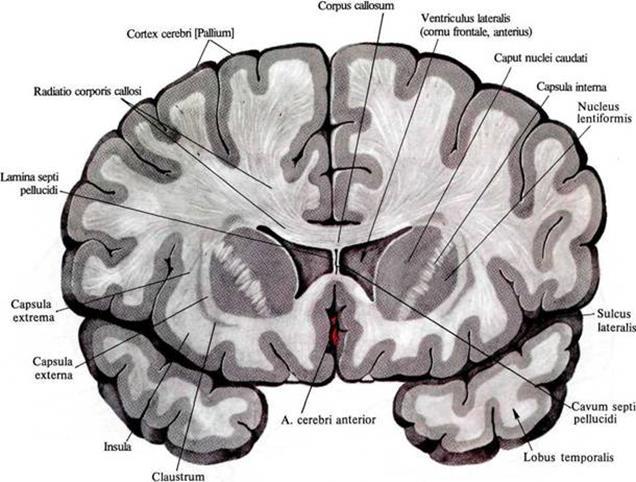
The distribution of white and gray matter in the frontal section of the brain
Structures that are closer to the center of the brain, it is customary to refer to the ancient brain. The ancient brain makes us related to animals and implements mechanisms, honed by evolution and more or less common to many living beings. The main volume of human gray matter falls on the cortex. The bark is a layer of gray matter with a thickness of 1.3 to 4.5 mm, constituting the outer surface of the brain. There are many arguments in favor of the fact that the core, unlike the ancient brain, implements not genetically incorporated algorithms, but is capable of learning and self-organization.
')
The main brain cells are neurons and glial cells. It seems that both of them play a significant role in information processes. To simplify the narrative, for now, we will only talk about neurons. Talk about glial cells postponed for some time.
Neurons are of different types. The most massive neurons in the cortex are pyramidal neurons. They account for 75% of all neurons in the cortex. The figure below shows them.
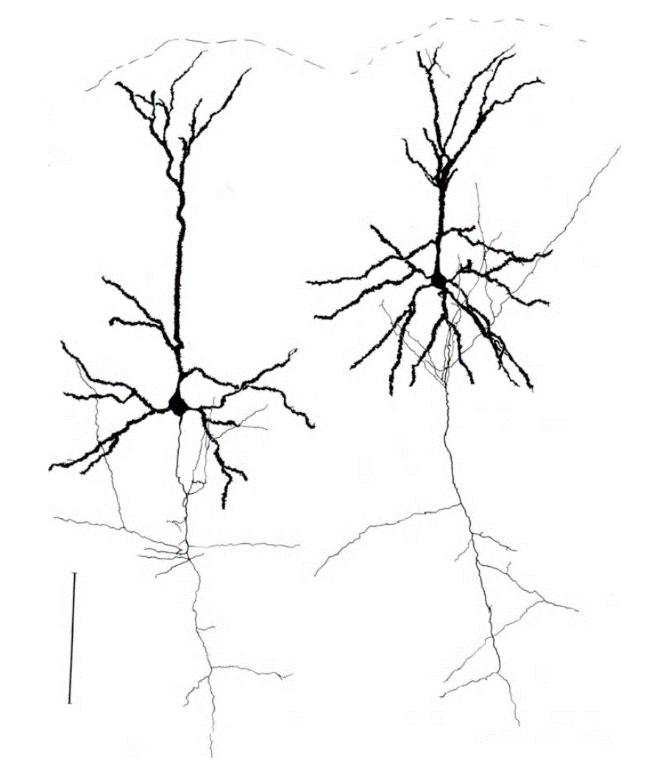
The structure of the pyramidal neuron, black - dendrite, gray - axon, ruler - 0.1 mm (Braitenberg, 1978)
Most neurons have a body, a dendritic tree and an axon. Both the axon and the dendrite branch strongly and form an entangled structure with many interweaving with the dendrites and axons of other neurons. You can get a general idea of the complexity and entanglement of the interweaving of axons and dendrites, for example, by video.
The general configuration of the neuron is well represented by the classic picture from Wikipedia.

The bodies of neurons, their dendrites and axons, the surrounding glial cells are all closely packed together, leaving only narrow slits free. These slots are filled with a complex solution, a significant part of which consists of electrolytes (mainly potassium, calcium, sodium and chlorine ions). Packing density can be seen and assessed in the reconstruction of a small volume of bark below.
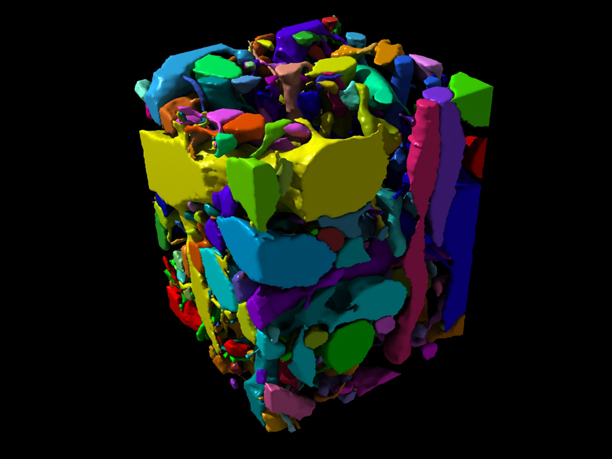
( connectomethebook.com )
The surface of the neuron is called the membrane. The task of the membrane is to protect the internal environment of the neuron from the outside. At the same time a huge amount of proteins are embedded in the membrane. Some of them pierce through the membrane and contact, both with the external and internal environment of the neuron. Such proteins are called transmembrane (figure below).

Transmembrane proteins
Transmembrane proteins perform different functions. If proteins transport ions to or from the cell and do it all the time, then these are ion pumps. To transport ions, proteins create ion channels. Ion channels can have external control, that is, open and close with certain signals. If the channel is controlled by a membrane potential, then we speak of potential-dependent ion channels.
If the protein reacts to a substance outside the neuron and transmits this reaction in some way inside the neuron, then these proteins are called receptors. A substance that acts on a particular receptor is called its ligand. If the receptor has an ion channel that opens under the influence of a ligand, then that receptor is called ionotropic. If the receptor does not have an ion channel and it affects the state of the neuron in a roundabout way, then this is a metabotropic receptor.
Receptors and other proteins are not concentrated somewhere in one place, but are distributed over the entire surface of a neuron. The average neuron of the cortex has about 10,000 synapses distributed over its dendrite and body. Each synapse accounts for several hundred receptors.
In the state of rest between the internal and external environment of the neuron there is a potential difference - the membrane potential of about 70 millivolts. It is formed by the work of protein molecules that work as ion pumps. Depending on their type, ion pumps change the ratio of certain ions outside and inside the cell. Pumps of the first type change the ratio of potassium and sodium ions, the second type — calcium ions are removed from the cell, and the third type — protons are transported outside. As a result, the membrane acquires a polarization, in which a negative charge accumulates inside the cell, and a positive one outside.
The places of contact of axons with dendrites or bodies of neurons are called synapses. The main type of synapse is a chemical synapse.
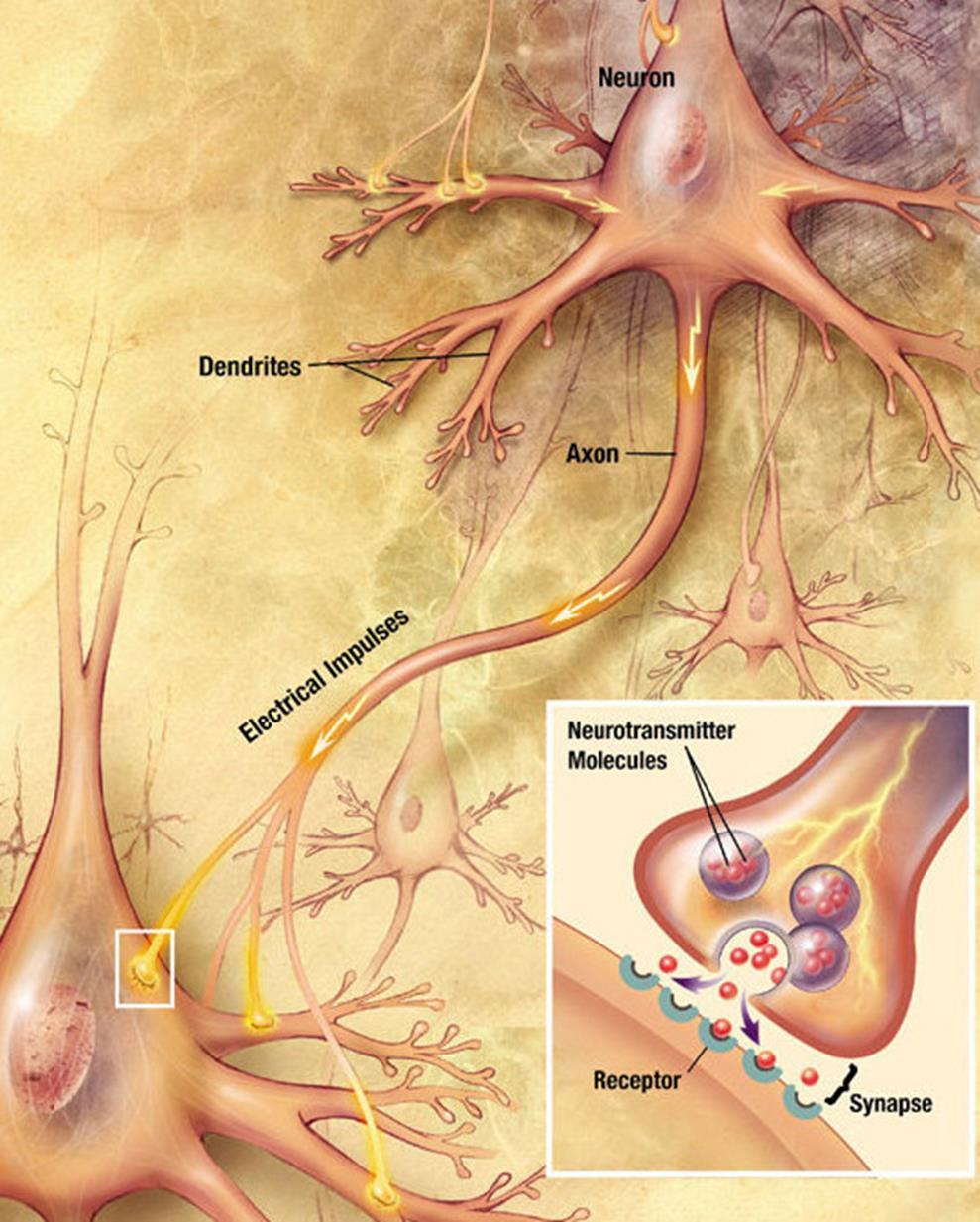
When the nerve impulse along the axon enters the synapse, it releases from the special bubbles the neurotransmitter molecules characteristic of this synapse. On the membrane of a neuron that receives a signal, there are protein molecules - receptors. Receptors interact with neurotransmitters. Receptors located in the synaptic cleft are ionotropic, that is, they are ion channels that can move ions. Neurotransmitters affect receptors in such a way that their ion channels open. Accordingly, the membrane is either depolarized or hyperpolarized, depending on which channels are affected and, accordingly, what type of synapse it is. In the excitatory synapses, channels open up, mainly transmitting cations into the cell, - the membrane depolarizes. In the inhibitory synapses, channels are opened, removing cations from the cell, which leads to hyperpolarization of the membrane.
The polarization of the neuron's membrane looks like an accumulation of ions in relative proximity to the membrane (figure below).
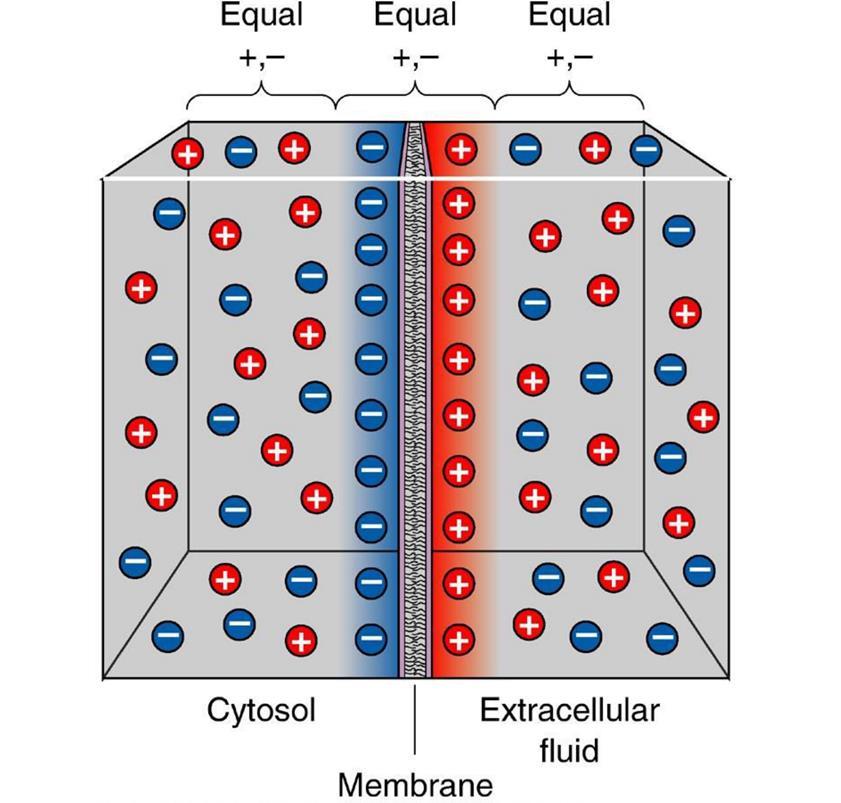
When the ion channels of the receptors open and the exchange of ions with the external environment begins, it is only in that place of the neuron surface where the receptors are located and the polarization changes. A small section of the membrane is charged differently than all its surroundings.
If excitatory receptors have been triggered, then the area in the appropriate place will be depolarized, that is, its potential will be higher than the average across the neuron membrane. If this depolarization reaches a critical value, a spike will occur, which will begin to spread across the membrane.
Potential-dependent ion channels are responsible for the emergence and spread of spikes. They are controlled not by neurotransmitters, but by the magnitude of the membrane potential. For example, for an axon, their work is as follows.
When the potential rises to a critical value, sodium channels open, which begin to drive positively charged sodium ions into the cell. Accordingly, the potential in this place is increasing like an avalanche. But at a certain point, potassium potential-dependent channels are activated. They begin to release positively charged potassium ions from the cell, thereby lowering the membrane potential. As a result, a short-term local surge of potential occurs. Then comes the refractory period when this place is insensitive to changes in potential. But a strong surge in one place leads to a less strong rise in potential in neighboring places. There, the threshold value is exceeded and a surge is born. As a result, the potential of action or otherwise the spike spreads along the entire length of the axon.
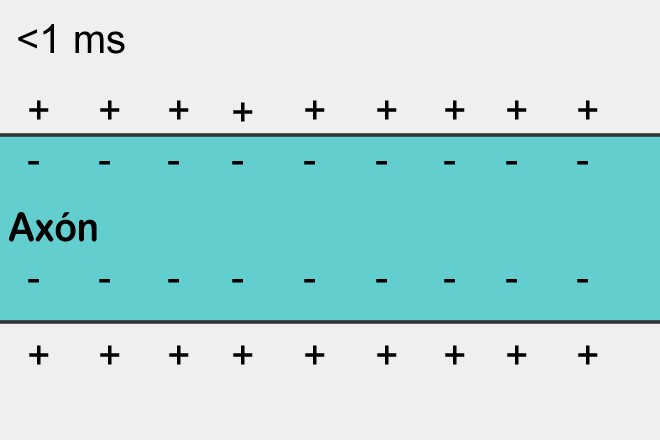
Spike propagation is a self-reproducing process. Spike, having arisen in one place, causes its neighboring places to generate its spike, and so on. This, by the way, resembles the simplest cellular automaton, similar to what we described in the previous section. Having arisen in one place the spike extends in all directions from this place. But if the spike did not arise in this place, but came from the side, then due to the fact that there is a refractory period, it can only spread to where it has not yet been.
In axons coated with myelin sheath, the action potential spreads somewhat differently. The myelin sheath does not allow the adhesion to spread, but, on the other hand, it well isolates the nerve fiber. As a result, an electrical signal is transmitted inside the isolated part, like a cable. Then, in the uninsulated area, the interception, a new spike is generated. Due to such “jumps,” the speed of nerve impulse transmission in thick myelin-coated axons is much higher than in nerve fibers without such a membrane.
The dendrites also have potential-dependent ion channels, and along them, as along an axon, action potential can spread. Axonal adhesions have an amplitude of the order of 100 mV, the amplitude of dendritic spikes is somewhat lower. Axonal adhesions occur on the body of a neuron in the dendritic knoll. From there they spread further along the axon. Excitation in the axon mound can also extend to the dendrite, in which case dendritic spikes arise, which are a signal of reverse propagation with respect to the axon action potential.
Dendritic spikes can also occur directly in the dendrite. This requires that in the course of a short time interval (about 3-10 ms), a lot of synaptic excitations occur on a small portion of the dendrite. For example, if the section length is 100 μm and the time interval is 3 ms, then it will take about 50 synapses to work in order for a dendritic spike to appear. It is worth considering that on this site is located about 200 synapses. One can achieve synchronous activity for a quarter of all synapses by artificially in vitro excitation. It is difficult to say whether this is possible in living tissue.
Spike propagation is not the only information transfer mechanism inherent in a dendrite. Dendrites have been shown to have cable properties. A dendrite branch can be matched with a cable that has internal resistance, leakage resistance and surface capacitance. Although the resistance of the dendrite is very high, and the leakage is significant, nevertheless, the currents that arise from excitatory postsynaptic potentials can have a significant impact on the general state of the neuron. It can be assumed that the role of these currents is especially great at short distances, for example, within one sprig of a dendritic tree.
Both axon and dendritic branches are thin tubes. Spike propagation along them is the movement of the annular depolarization region. But spikes are quite energy-intensive phenomena. In addition to them, there are weaker, but more massive signals. Neuroscientists, at times, say that neurons generally do not shout at each other (meaning adhesions), but whisper.
Let's return to the chemical synapse. The nerve impulse, spreading along the axon, reaches numerous axon terminals. Most of the terminals form contacts with dendrites. These are chemical synapses. Reaching the terminal, the spike causes a massive release of neurotransmitters into the synaptic cleft. Neurotransmitters are packed in special vesicles (vesicles). One vesicle contains several thousand molecules.
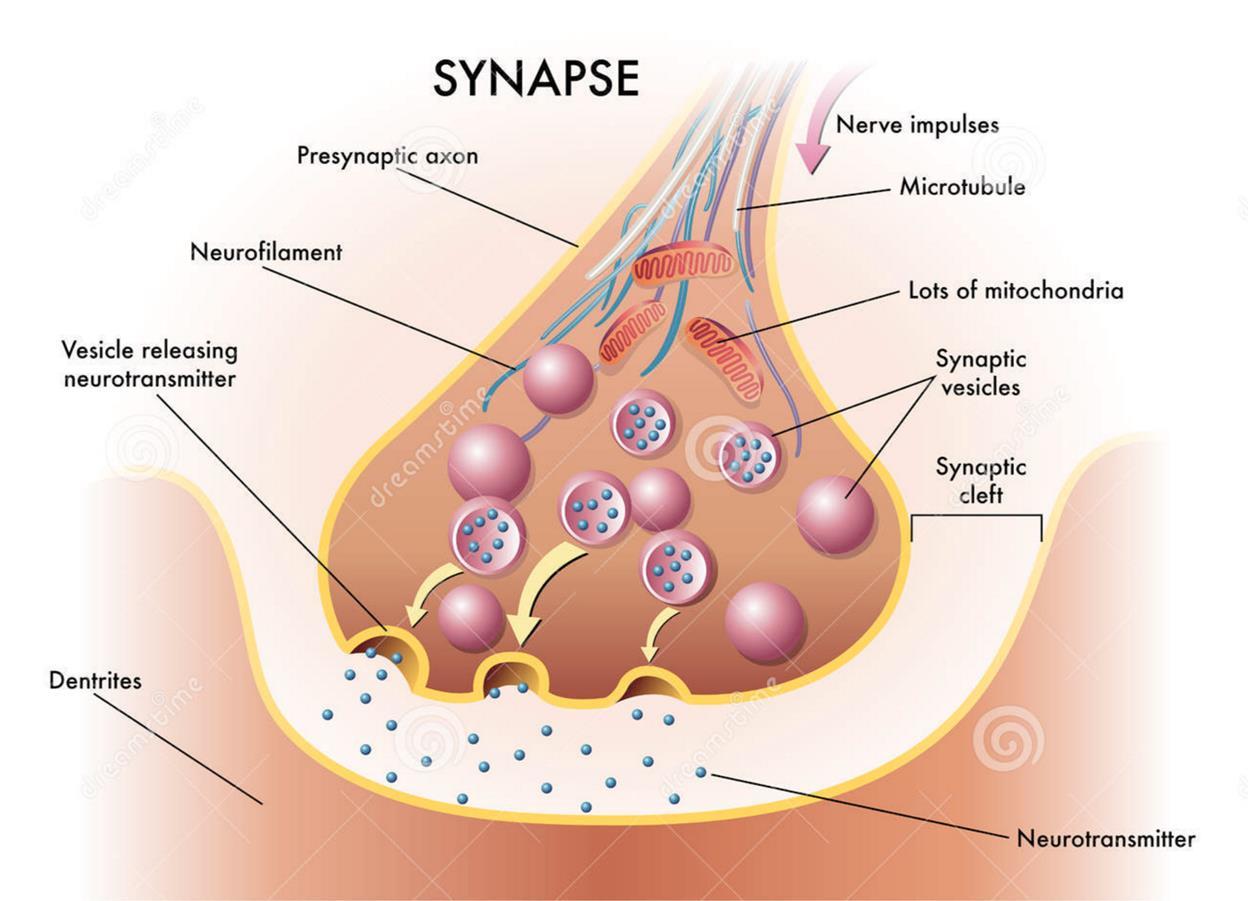
The arrival of spike causes a massive release of neurotransmitters, consisting of a dozen bubbles. The dose of neurotransmitters contained in a single synaptic vesicle is called the neurotransmitter quantum.
In addition to the mass release of neurotransmitters that occur at the time of the arrival of the axon spike, there is also the so-called quantum emission, when only one vesicle with neurotransmitters is released. Moreover, quantum activity may not be associated with the activity of neurons to which the synapse belongs and occur independently of it.
The measurements made near the synapses show that on the membrane next to each synapse excitatory postsynaptic potentials are recorded from time to time, having an amplitude of the order of 1 mV or multiple. It is believed that such miniature postsynaptic potentials are associated precisely with the quantum emission of neurotransmitters.
When neurotransmitters are ejected into the synaptic cleft, part of the mediators fall outside the synaptic cleft and spread over the space formed by the neurons and the glial cells surrounding them. This phenomenon is called spillover. In addition, mediators are emitted by non-synaptic axon terminals and glial cells (figure below).

Sources of mediators outside the synaptic cleft (Sykova E., Mazel T., Vagrova L., Vorisek I., Prokopova-Kubinova S., 2000)
When something happens on the neuron's dendrite this is accompanied by the release of neurotransmitters. Inside the synapse, neurotransmitters affect ionotropic receptors and, as a consequence, local changes in the membrane potential of the dendrite. When neurotransmitters fall outside the synapse, they begin to affect everything that is in close proximity. It does not matter whether there is direct contact between these elements. This can be compared to a crowd of people. People in a crowd can break up into couples and conduct conversations with each other, but not only the interlocutors themselves will hear these conversations, but their closest neighbors.
More about synapses, I must say that not one neurotransmitter is stored in their synaptic vesicles, but a certain cocktail. As a rule, it is a mixture of one main neurotransmitter and several additional neuropeptides, which are called neuromodulators. Thus, the spilover throws a whole set of signaling substances out of the synapse. Different neurons of the same type can have a common primary neurotransmitter, but at the same time, they differ in additional composition.
Most synapses, about three-quarters of their number, are located on small processes called spines. Spines move the synapse away from the dendrite and create a distribution of synapses in space that the synapses from different dendrites are mixed together.

Reconstruction of the site of the pyramidal dendrite cell. Synapses on spines are marked in red, on dendritic stem in blue (Dr. Kristen M. Harris)
If you take a section of the dendrite with a length of 5 μm (figure below), then it will be about ten synapses. But the dendritic branches of some neurons are closely intertwined with the branches of other neurons. They all pass from each other in the immediate vicinity. About 100 synapses fall into a cylindrical volume 5 μm in height and also 5 μm in diameter. That is, 10 times the amount that is directly located on the dendritic branch itself.
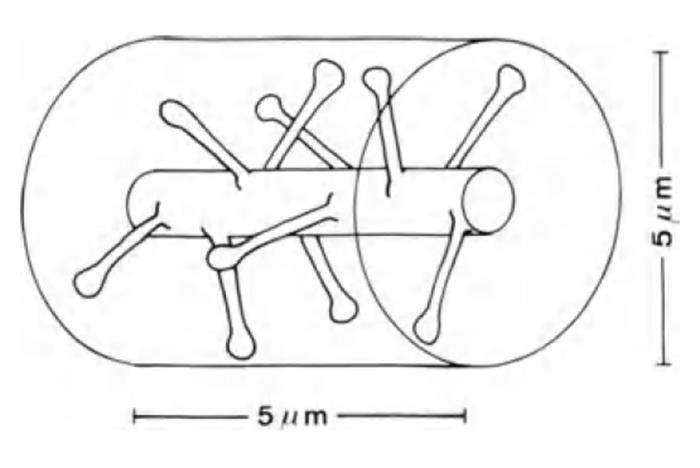
Dendrite site (Braitenberg V., Schuz A., 1998)
As a result, synapses form a system of randomly distributed sources of neurotransmitters for the extra-synaptic environment. Any activity in the synapses causes the appearance of neurotransmitters in their surrounding space. If somewhere at the same time several neighboring synapses become active, then in such a place a cocktail arises from those mediators that have emerged from these synapses.
If you take any place, close to each other in a radius of one and a half micrometers will be about 10 synapses. Most of them will belong to different dendrites. If you observe what combinations of neurotransmitters will appear in this place, then it turns out that the composition of the "cocktail" can be fairly accurate to say exactly which synapses were active each time.
You can give an example. Imagine that there are 10 bars in the area. There are a hundred beers in total. In each poured only 3 sorts of beer. The bartender chose these varieties in each bar once at random and now only pours them. You go around a few bars, drink three beers of different sorts in each and take with you cardboard coasters for glasses with the name of the beer you have drunk. As a result, by the combination of cartons, almost always, your wife will be able to determine which bars you visited.
Neurotransmitters that are outside the synapses have their own specific mechanism that allows you to influence the work of neurons. Large amounts of metabotropic receptors are located on the surface of the dendrite and the body of the neuron. These receptors have no ion channels and cannot directly affect the membrane potential of the neuron. On the inner side of the membrane, these receptors are associated with the so-called G-protein. For this they are often called “G-protein-coupled receptors (GPCRs)”. When metabotropic receptors are activated by their ligand, they release the G-protein and it begins to influence the internal state of the cell.
There are two types of effects of G-proteins on the cell (figure below). In the first case, G-proteins directly bind to the nearest ion channels and open or close them, which accordingly changes the membrane potential. In the second case, G-proteins bind with enzymes that trigger the work of secondary messengers. The use of secondary intracellular mediators leads to a multiple increase in the efficiency of receptors. Changes caused by secondary mediators are slow, but they can globally change the state of the entire cell.
The work of ionotropic receptors is called fast interaction. To change the membrane potential takes time of the order of just one millisecond. The work of metabotropic receptors is usually referred to as slow interactions. With the involvement of secondary intermediaries, changes in the cell can last from seconds to hours. Direct control of metabotropic receptors of ion channels is much faster and is comparable in time with the rapid interaction.
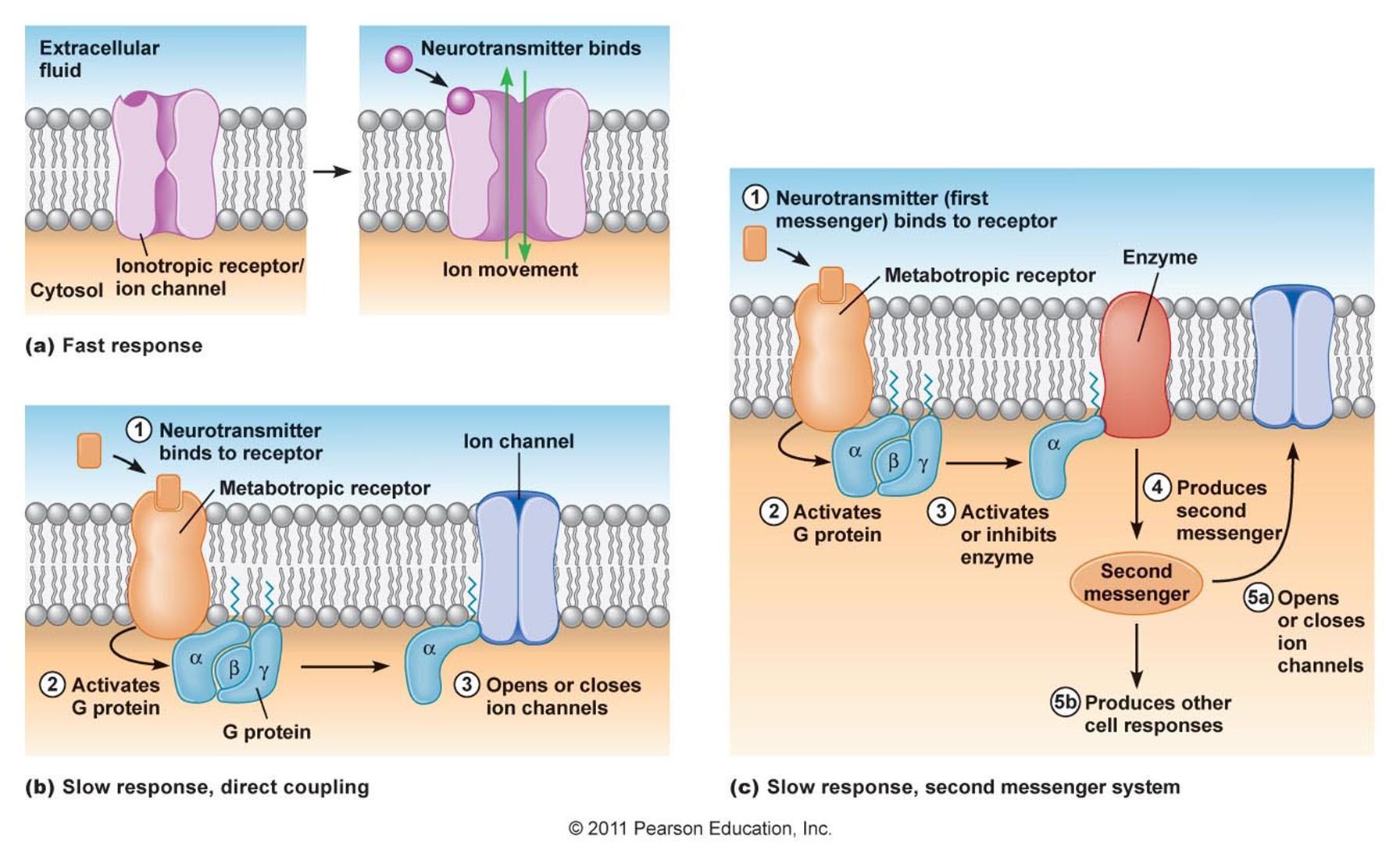
If you look at the metabotropic receptor closer, it turns out that it has seven transmembrane domains and two free ends (figure below).

The structure of the metabotropic receptor
Due to the free ends, adjacent receptors can be connected, creating dimers (figure below). Dimers, in turn, uniting, form receptive clusters. The amine and carboxyl ends of the receptors serve as peculiar sticky fasteners, which, due to electrostatic "sticking", can form receptor clusters of different composition. Since there is nothing accidental in biological systems, it can be assumed that the formation of clusters from various metabotropic receptors has a certain meaning. If we assume that the receptor cluster responds to neurotransmitters not separately, by each receptor independently, but as a single mechanism, then such a reaction can be compared with the detection of certain combinations of substances formed during spilover of neighboring synapses.

Receptor clustering. A is a single receptor and its interaction with surrounding receptors. B is a monomeric receptive molecule. C - receptive dimer. D is the combination of two monomers into contact (E) and combination (F) dimers. (Radchenko, 2007)
Above, not all mechanisms involved in the work of a neuron are described. But this is already enough to realize that a real neuron is not just much more complicated than its formal analogue. A real neuron is something completely different. It seems that neural networks are a human invention that has no direct analogues in nature. When an artificial neural network manages to solve any practical problems, it seems that the analogies with the brain should be done not at the level of neurons and connections, but at the level of the algorithmic principles that this network implements.
Let us return to cellular automata and the question of a possible biological analogy. In order to claim the role of an element involved in the transfer of information, an applicant must meet several requirements:
- The candidate must have at least two states;
- It must be possible to transmit information about their condition to their neighbors;
- There should be a mechanism that allows the candidate to change his state under the influence of the pattern created by the activity of the neighbors;
- There should be a mechanism to selectively respond to the various surrounding patterns;
- The transfer of information must be fast enough to match the rhythms of the brain;
- Since it is assumed that the pattern-wave mechanism should every time involve a large number of elements in the transmission, the energy costs of each element should be minimal.
At different times, I considered different candidates for the role of biological analogues. The abundance of mechanisms intrinsic to the brain allows for almost everything in the cortex to come up with a hypothetical rationale for why this may be analogous to the elements of the cellular automaton. Now I am inclined to think that the most suitable candidate is thin branches of dendritic trees.
The branches of dendritic trees are undoubtedly an integral part of the neurons and participate in the general mechanism of its operation. But this does not prevent them from manifesting individual properties and being in some situations autonomous elements.
When a miniature excitatory postsynaptic potential arises on a branch, it spreads like a cable within the limits of the length of this branch. It can be assumed that the propagation of an electrical signal provokes the minimal emission of neurotransmitters from each synapse belonging to this branch. In this case, the emission does not affect the membrane potential of the dendrite, but mainly extends beyond the synapse. From the outside it will look like a constant leak of neurotransmitters. The state in which an electric signal runs through the dendrite can be called the active state of the element. At the moment of activity of the dendrite branch, a cloud of neurotransmitters is supposedly created around it. In each place of this cloud, the composition of the cocktail is individual and is determined by the nearest synapses.
In each place of the cortex, about a dozen synapses from different dendrites coexist. If several dendrites are active simultaneously, then in certain places a cocktail specific to this combination of neurotransmitters occurs. If in such a place there is a dendrite with a metabotropic receptor sensitive to this particular cocktail, then such a dendrite can receive exciting potential and become active.
In principle, it is not difficult to assemble the biological analogue of our cellular automaton from such a constructor. Due to the fact that we are talking about miniature postsynaptic potentials and quantum emission of neurotransmitters, the energy of such a transmission will be extremely low.
In the cellular automaton, in order to create unique patterns, a random initial selection of states and the memory of the automaton elements relative to their familiar patterns were required. This resulted from the fact that initially the cellular automaton was pure and homogeneous. For the occurrence of any repeated heterogeneity, the automaton required randomness and memory. With dendrites, the situation is somewhat more interesting. The dendritic branches are initially strongly intertwined, and completely random. Such heterogeneity, in fact, is already a ready-made memory.This memory allows you to perceive any signal and produce a response predetermined by the structure of weaves. Moreover, the answer is repeatable. This is like a hash function that produces a result that may not be very clear, but it is always the same for the same input signal.
Simplified it looks like this. Create a pattern of several branches in the local area. Somewhere in the volume of this local area, there will be places in which these branches will pass next to each other. Neurotransmitters emitted from them will create "cocktails". If dendritic branches on which the corresponding receptor appears in this place will be next to the “cocktails”, then this branch is activated.
That is, the random weave system itself already contains within itself a mechanism for creating a continuation for any combinations of activity. This is convenient, since, potentially, does not require additional memory other than what is already embedded in the chaos of weaves. But such a construction has only local temporal stability. If the configuration of dendrites or spines changes, then all the resulting patterns can be dented. It can be assumed that if the brain really chose such a mechanism, then there must be systems that ensure the stability of the patterns used, the optimization of their propagation and the minimization of the probability of propagation errors. It is possible that changes in dendritic trees and changes that occur with the number and shape of spines are echoes of such optimization.
To illustrate the assumptions described, Anton Morozov made a 3D scale model in which he reproduced waves based on patterns from dendritic twigs. In the model, the branches were replaced by thin tubes 50 μm in length, which corresponds to the average length of the dendritic branch. With the same packing density of the dendrites as in the real crust, something like the one in the figure below was obtained.

Sets the initial compact twig pattern. In the model, the branches do not have their own memory. Activated those branches for which it dictates the geometry of random links. Accordingly, any random pattern of active branches generates a continuation pattern predetermined by the geometry. The new pattern gives rise to the next and so on. Below are a few modeling steps.

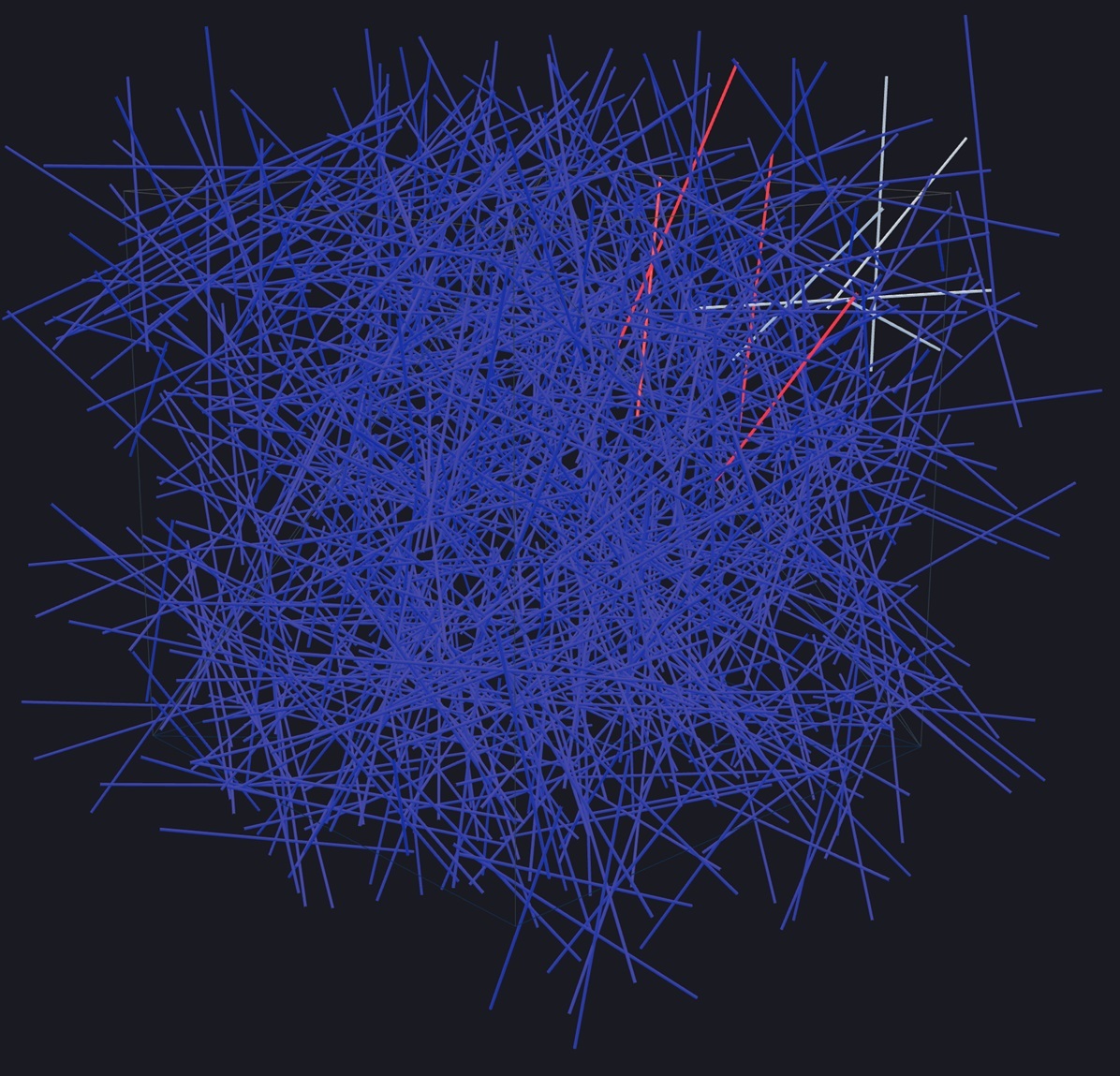
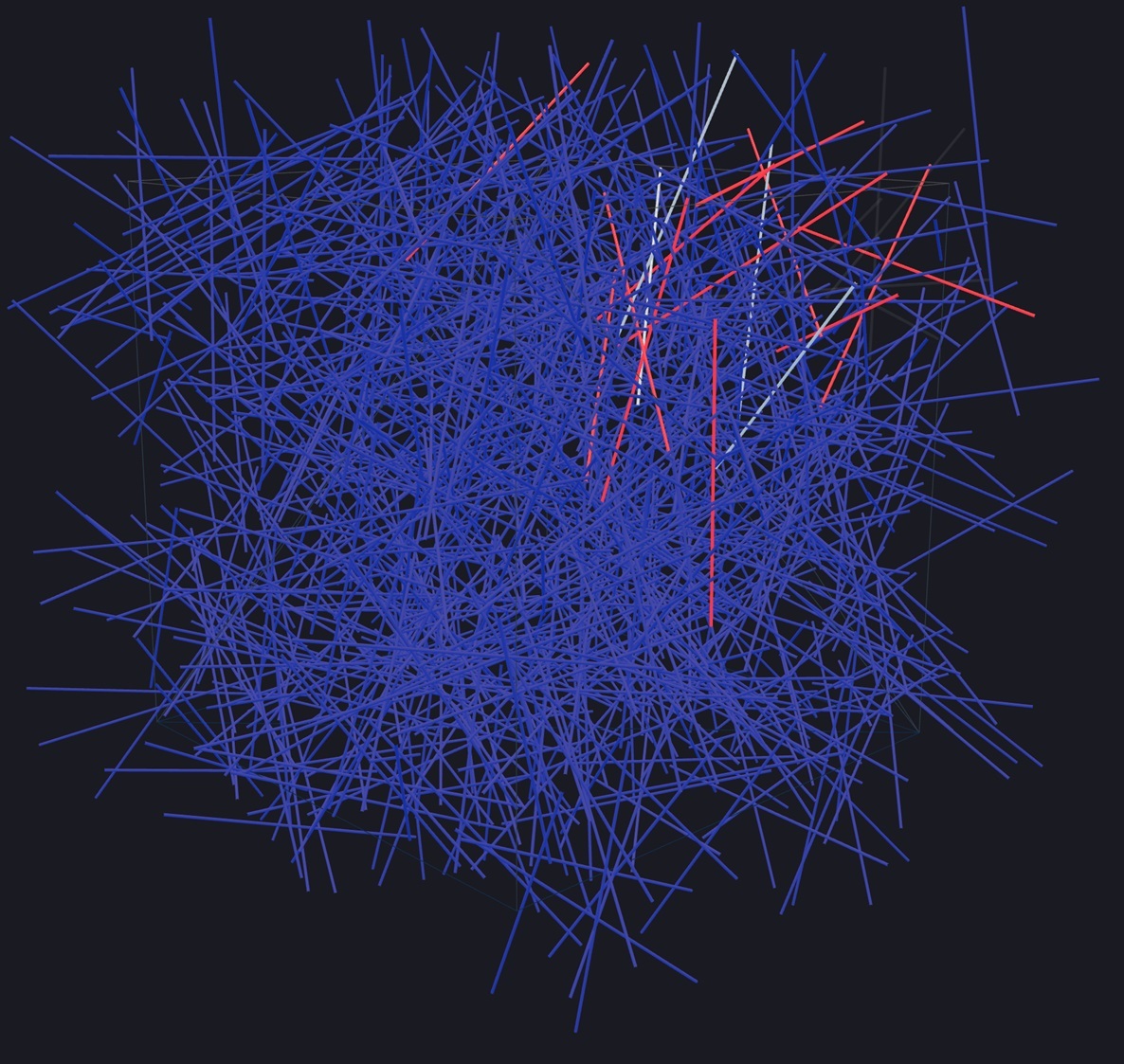
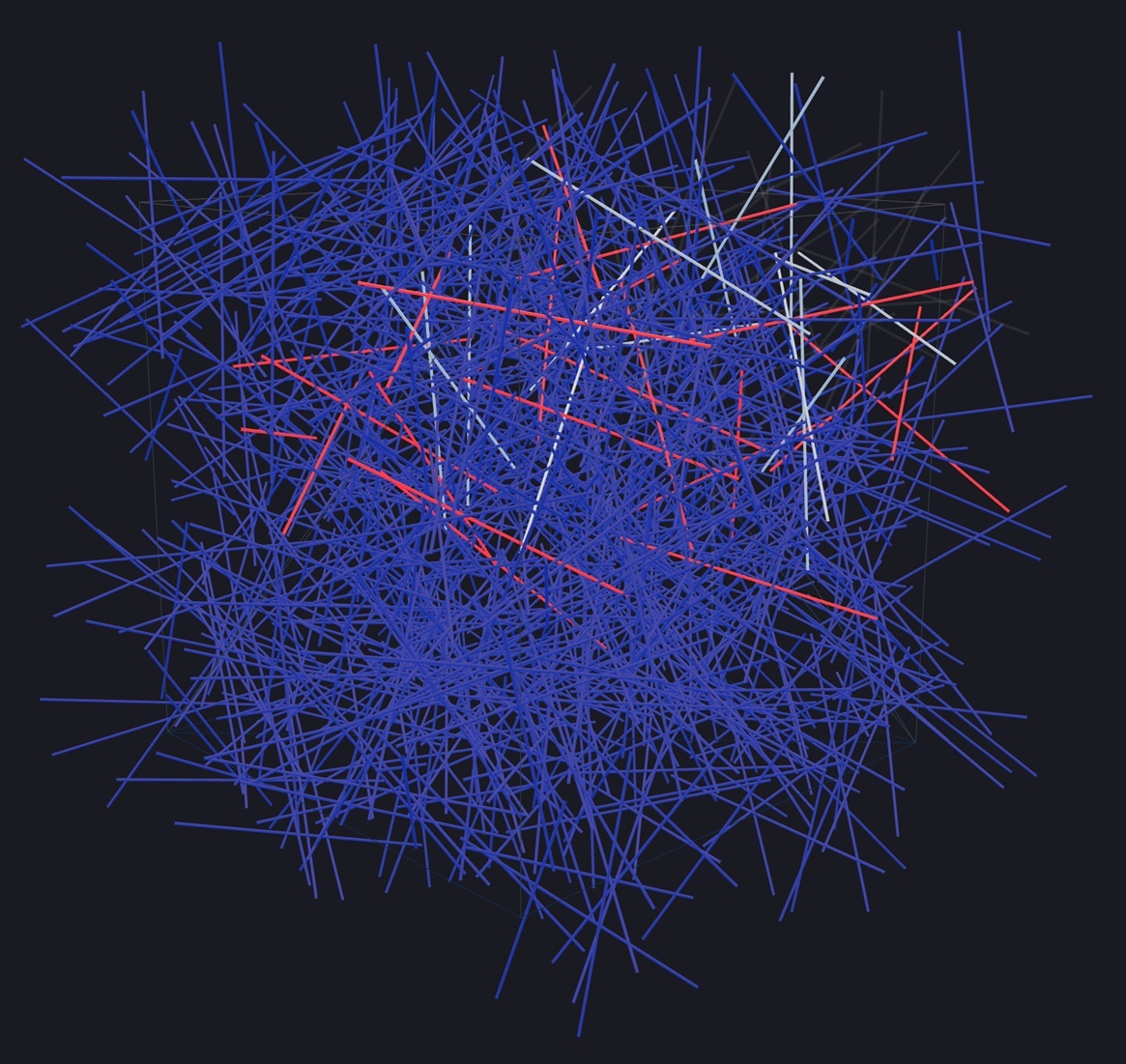
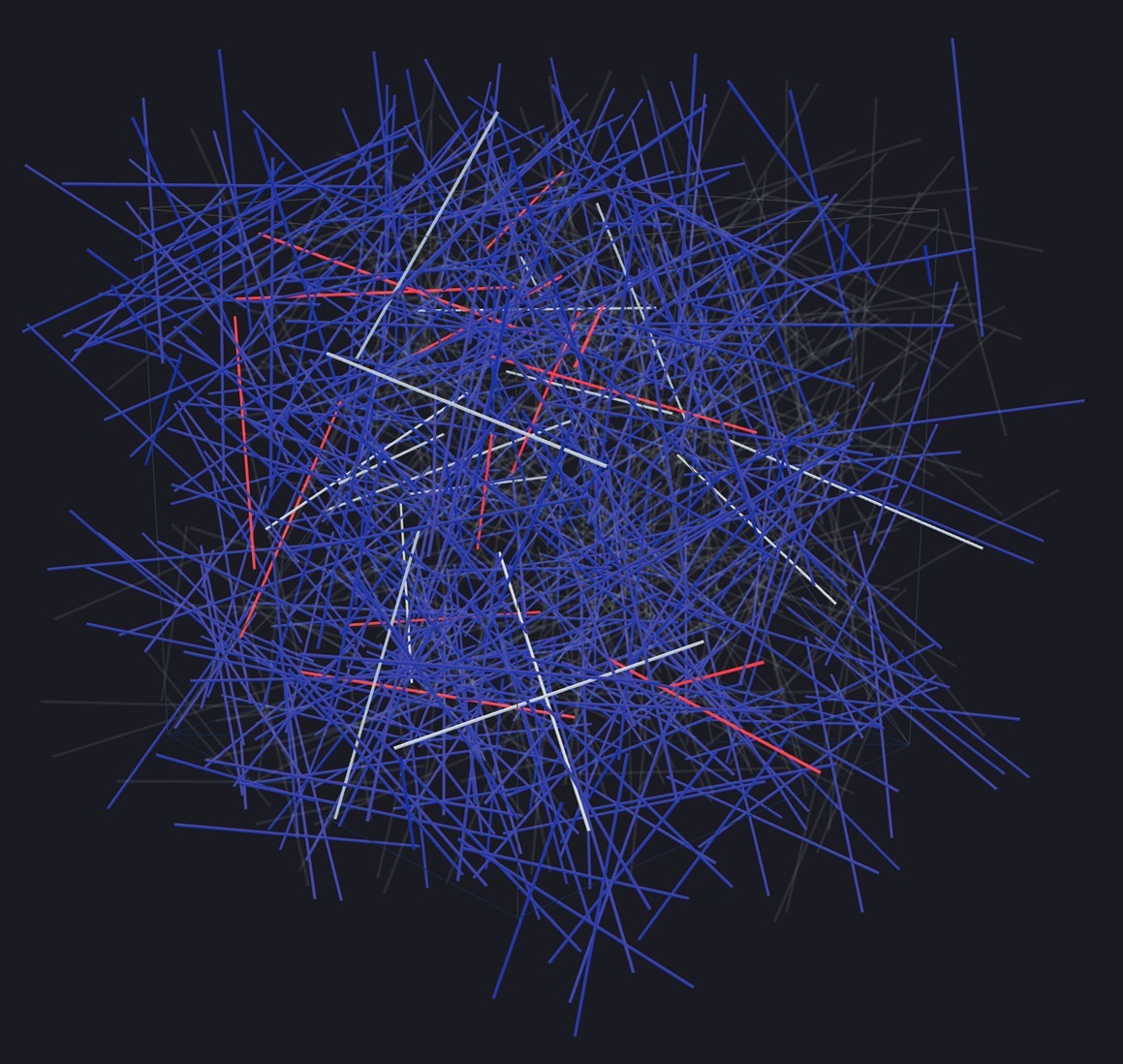
It is not worth looking for any deep meaning associated with information processing in the described mechanism for the propagation of dendritic waves. In fact, we simply showed a possible mechanism for transmitting discrete information across the space of the cortex and between brain structures. Incidentally, it is similar in its idea to the mechanism for transmitting digital information over data buses used in computers. The data bus function is to transfer a pattern made up of zeros and ones to all nodes of the computer. The data bus is somewhat simpler, its pattern looks the same anywhere on the bus. But, theoretically, you can imagine a computer in which the bit signal on the data bus will change as you move from one node to another. If the one-to-one correspondence of the codes obtained is observed, it is easy to adjust the computer nodes to work with such information.But do not underestimate the resulting model. Further we will show that the development of this model gives amazing results.
Alexey Redozubov
The logic of consciousness. Introduction
The logic of consciousness. Part 1. Waves in the cellular automaton
The logic of consciousness. Part 2. Dendritic waves
The logic of consciousness. Part 3. Holographic memory in a cellular automaton
The logic of consciousness. Part 4. The secret of brain memory
The logic of consciousness. Part 5. The semantic approach to the analysis of information
The logic of consciousness. Part 6. The cerebral cortex as a space for calculating meanings.
The logic of consciousness. Part 7. Self-organization of the context space
The logic of consciousness. Explanation "on the fingers"
The logic of consciousness. Part 8. Spatial maps of the cerebral cortex
The logic of consciousness. Part 9. Artificial neural networks and minicolumns of the real cortex.
The logic of consciousness. Part 10. The task of generalization
The logic of consciousness. Part 11. Natural coding of visual and sound information
The logic of consciousness. Part 12. The search for patterns. Combinatorial space
Source: https://habr.com/ru/post/308878/
All Articles